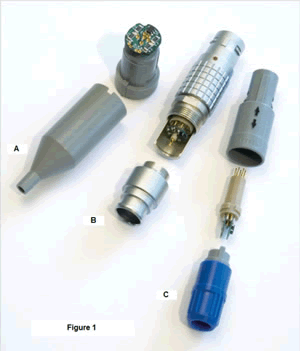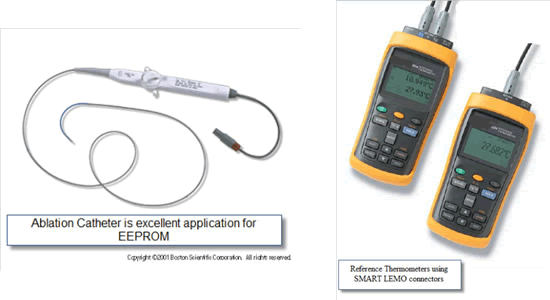Integrating Electronics into Connectors Gives New Flexibility to Medical Device Designers
Specialized connectors that integrate other components save space and add capabilities.
By Julie Carlson, Marketing Manager, LEMO USA
Design engineers who create small, portable devices such as those used in medical and military equipment face a challenge: the need to save valuable PCB space. One popular solution is to integrate electronics into a connector. One successful example of this concept is a connector that integrates noise filtering and electromagnetic pulse suppression (EMP) components into the rear shell of a circular or rectangular connector.
In medical device designs, integrated solutions can be achieved by designing a small PCB that fits a small, surface-mount circuit with IC packages such as the thin small-outline C-lead (TSOC), small-outline transistor (SOT), small outline (S), and passive SMD components, such as resistors, capacitors, and fuses.

Single-patient-use receptacle for cable mounting (A), shielded metal plug for cable mounting (B), and plastic plug for cable mounting (C)
“One of the trends we see today is a smart medical device using a microcontroller and EEPROM, integrated with the connector plug or receptacle,” said Steven Lassen, product and applications manager, LEMO.
Using an electrically erasable programmable read-only memory (EEPROM) makes many new features possible for medical devices. For example, using this solution with disposable probes enables the main device to keep count and give an error message or disable the disposable unit if it’s used too many times. This prevents operator error and allows logging of usage, and even alleviates potential liability issues related to equipment connections.
This EEPROM solution can also serve as a method of electronic serialization. Electronic serialization or tracking can reduce problems such as insufficient space, permanency, poor cosmetics, and legibility. Memory in the probe allows for calibration and unique adjustments of each probe. Another benefit of integrated electronics is the ability to prevent pirating and counterfeiting via built-in code and authentication features. (See Figure 2 for a typical circuit using a microcontroller.)

Other features made possible with an EEPROM:
- Anti-counterfeiting: Only products with valid codes will function.
- Encoding and device type ID: Automatically recognizes different device and probe types when attached to the same port.
- Enables on-board calibration and storage of unique calibration and offsets.

EEPROMs can enhance medical applications including: exploratory catheter diagnostics, medical therapeutic ablation, test and measurement with probe calibration, and sensors and devices with transducer electronic data sheet (TEDS) requirements.
Integrated Electronics
Medical device designers may also consider custom circuits for noise filtering or electromagnetic interference (EMI) suppression, signal conditioning, temperature sensing, or circuit protection integrated on a PCB within the connector. These circuits place the electronics in close proximity to the probe, sensor, or noise source to improve system performance.
There are a variety of ways to mount and orient a PCB, depending on the application needs. PCBs can be mounted perpendicularly through the PCB contacts of the connector (see Figure 1B) or axially and surface mounted to the connector contacts (Figure 1C). The connector shell serves as a protective enclosure for the electronics, reducing warranty expense for repairs.
LEMO USA offers metal connector models, such as the B or K Series, with shells that provide and maintain shielding for EMI protection (Figure 1B). If shielding is not a concern, the company offers plastic options, such as the REDEL P Series or the new XP Series connectors, which provide a lightweight, aesthetic, and ergonomically pleasing package (Figures 1A, 1C). With LEMO USA’s design partners, rigid PCBs or flex circuits can also be added as needed for the application.
Fitting electronics directly into connectors opens up new avenues to designers who are creating the small, portable, and flexible equipment enabling the future of modern medicine. Designers can work with connector companies that have prototyping capabilities to help bring a connector with integrated electronics from a design concept to a working prototype.
LEMO has been designing precision connectors for more than seven decades. The company has more than 75,000 combinations of product that continue to grow through custom designs. LEMO and its affiliated companies, REDEL, NORTHWIRE, and COELVER, currently serve more than 100,000 customers in over 80 countries around the world.





